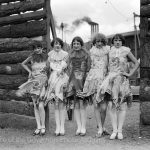
We’ve just started a cooperative project to scan old film and glass negatives held by the Raton Museum.
Here’s what’s on top in the first box!
Unidentified film negative from the Raton Museum collection, HP.2015.26.171
Update:
lex3232 asked
Are these prostitutes?
We’ve been curious about these women too.
Most of the photos in this project do not have much documentation, so we don’t really know a lot about them. We may discover more as we work, and we may get feedback from the Raton Museum, as well as those with an in depth knowledge of Raton or other historical subject matter, like clothing.
Our most likely guess at this stage is that they are a group of performers or entertainers of some sort or are simply locals dressed up for an event. Many negatives in this box are associated with “Days of ‘49″ circa 1927-1928, which was a Raton festival celebrating the city’s frontier era (with a reference to its mining heritage, via the California Gold Rush of 1849 and the 49ers that came with it). Many western towns, including Silver City, New Mexico, had “Days of 49″ events in the 1920s and 1930s.
Were they in the parade? Were they locals performing in a revue of some sort? Were they attending the event costumed to evoke saloon girls or “buffalo gals” who would have entertained men at nearby mining camps? Or were they staffing the event?
We had one suggestion that they were miners in drag. This is a plausible suggestion, but we don’t see anything that really screams drag, above and beyond the exaggerated makeup and costume-y look of their dresses. Though their bobbed hair is in a current style for the twenties, it doesn’t look as polished as I’ve seen on other ladies in New Mexico, but I also don’t see anything to suggest these are wigs.
Their dresses are coordinated in construction and materials, but not expensive or professionally made (that is, they don’t seem perfectly tailored for each individual nor like they were made for traveling theater stars of any kind who might have been in the area to perform at the Shuler or with a circus). Despite the coordination of their clothing, their shoes don’t match. The group is wearing heavy make up in a way that says “entertainment.”
Several are wearing rings. Though ruffled collars were popular and stylish in the 1920s, these ruffled collars are not of the popular style and do look circus- or carnival-like; we’d love feedback from anyone who might know more about the collars. If they are in drag, this could be a clue. Another thing to note is the length of their dresses. They don’t have a dropped waist, which would have been en vogue, and they are fairly short, even for the 1920s. A real, famous showgirl might have worn something skimpier, a typical woman would have worn something longer. However, instead of exposing garters, the tops of stockings, and a bit of thigh, several of the ladies are wearing dark shorts, which is awkwardly modest.
All of this leads me to think amateur theater or dance performers or simple festival-goers, but, in short, we don’t really know. They are probably not prostitutes, but their costumes might be a tongue-in-check reference to prostitution on the frontier.
